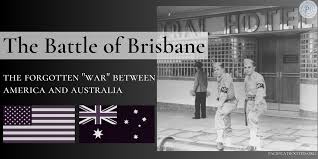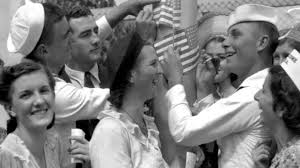The Battle of Brisbane, a violent two-night clash between Australian and American servicemen in November 1942, remains one of the most extraordinary and yet under-discussed episodes of Allied wartime friction.
In Australia—particularly in Brisbane—it has entered popular memory as a moment of explosive resentment toward the dominant American presence. In the United States, however, it remains virtually unknown, often omitted entirely from military histories or reduced to a disciplinary anecdote.

This article compares how the two nations have remembered—and forgotten—this dramatic rupture in wartime alliance.
What happened?
The riot began on 26 November 1942, when tensions erupted outside the American PX (Post Exchange) on the corner of Creek and Adelaide Street, Brisbane. Australian servicemen and civilians, frustrated with what they perceived as American privilege—better pay, access to luxury goods, and greater popularity with local women—confronted U.S. military police.
When an American MP struck an Australian soldier with a baton, the situation escalated. Reinforcements on both sides arrived, and by nightfall the city centre descended into street violence involving hundreds. The riot continued into the next night.
One Australian soldier, Gunner Edward S. Webster, was killed by a gunshot from a U.S. 12-gauge Stevens pump-action shotgun. Dozens were injured.
How the two sides remember it
A comparative perspective
| Aspect | American Perspective | Australian Perspective |
| Narrative framing | A regrettable disciplinary issue; rarely discussed | A flashpoint in unequal relations within the Allied alliance |
| Media coverage (WWII) | Censored entirely in U.S. wartime media | Restricted locally during the war, but widely discussed post-war |
| Death of Edward Webster | Largely omitted from official U.S. reports | Central to the Australian telling of the event |
| Cultural memory | Virtually forgotten; not part of national memory | A significant moment in Brisbane’s WWII legacy |
| Military response | Handled internally with stricter patrols and discipline | Viewed with concern, but with limited ability to influence U.S. conduct |
| Post-war literature | Only briefly mentioned in U.S. texts, mostly as anecdote | Explored in books, oral histories, documentaries, and local history tours |
| Symbolic interpretation | A minor blemish in Allied cooperation | A symbol of tensions and imbalance in the wartime relationship |
A moment that still resonates
The Battle of Brisbane revealed underlying tensions in the Allied relationship. While Australian troops were grateful for the American support against Japan, many also felt overrun—economically, culturally, and socially—by the overwhelming U.S. military presence.

The phrase “overpaid, oversexed, and over here” captured the public mood of the time.
The U.S., focused on victory in the Pacific, treated the riot as a local issue to be quietly resolved. Australian perspectives, however, have kept the memory alive—particularly in Brisbane, where the incident is remembered as a symbol of wartime inequity.
Why it matters
Alliances, even during moments of shared struggle, are not without friction. The Battle of Brisbane challenges the simplified image of harmonious wartime cooperation and reminds us that lived experiences during war—especially for those stationed at home—can be as complex and charged as those on the battlefield.
It also raises important questions about how history is remembered. What is forgotten, and by whom? What gets retold, and what is silenced?
Further reading and sources
Battle of Brisbane OzatWar website
Peter Stanley, Bad Characters: Sex, Crime, Mutiny, Murder and the Australian Imperial Force (Murdoch Books, 2010).
– Chapter 14 includes an account of the Battle of Brisbane, with particular emphasis on tensions within the AIF and between Australian and U.S. troops.
Brisbane’s WWII Heritage Trail, Brisbane City Council (brochure & online archive).
– Contains local historical interpretation and site references to Queen Street and the American PX.
National Archives of Australia (NAA), Brisbane police and military records, 1942
– File series: MP742/1 and MP508/1 contain incident reports and communication between local and federal authorities regarding the disturbance.
Articles from Trove, National Library of Australia
Article based on reports published in The Courier-Mail (November–December 1942).
MacArthur Museum Brisbane, Queen Street –
– Exhibits and oral history recordings provide firsthand accounts from both Australian and American veterans who witnessed the event.
